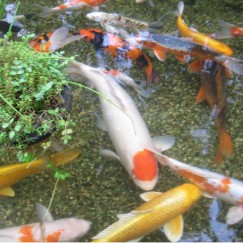Spring Cleaning Your Water Garden
Spring Cleaning Your Water Garden might not be as hard as you think.
In spring pond owners are often itching to get out there to empty the pond, scrub the sides and give the filter a really good hard clean, thinking they are doing a very important service. But this is often detrimental.Small Regular Cleans
Ponds can take up to a year to create a balanced micro system crucial to a healthy pond. Stripping and cleaning your pond and filter will remove the good bacteria which in turn can take many months to build back up again, not to mention the stress on the fish during the cleaning process. Obviously removing fallen leaves and debris with a net is a good idea, clean filters only when the water flow is reduced, and only one or two of the filter mats at any one time, (filters with back washes can be done as often as you like). Ponds with a thick layer of fine gravel on the base, a good filtration system and the right amount of fish (the more fish you have the less algae), should be relatively maintenance free.
So only clean if you really have to, and if possible try doing small cleans regularly, rather than one big spring clean. The following are task that can be done with confidence around springtime.
Spring Cleaning
Spring is the time when most aquatic and marginal water plants are emerging. They will enjoy a trim and a feed. Any plants that are pot bound can be divided now resulting in great summer foliage. The majority of water plants respond really well to a hard prune, removing any old and unattractive foliage encourages more growth.
Feeding Your Plants
A light feeding will be well received, especially by the flowering varieties such as Water Iris, Water Canna, Pickerel and Thalia. If your water lily does not require repotting, it will definitely benefit from fertilising.
Using a dedicated water plant pellet, push the pellet as deep as you can into and around the growing tip of the lily.
Repotting Water Lilies
If your Hardy water lily didn’t perform well in the season just gone, it will be a great time to lift it out of the pond and re-pot. (Note leave your tropical water lily alone until November/December when you will need to fertilise).
Take your hardy water lily out of the pot and expose the rhizome. Measure back about 7-10cm from the tip or crown of the plant and cut through with a sharp knife. Discard the excess woody rhizome and roots. Position the newly cut crown of the plant into a quality water plant potting mix, fertilise with 2-3 Mantuec slow release water plant tablets, place heavy gravel on top of the pot (to keep the soil in and the fish out) then soak in a bucket of water for about 5 minutes, then place it directly onto to base of the pond.
In the event that you are repotting many plants and lilies at the same time, your pond will be receiving a large dose of nutrients quickly from the potting mix and plant pellets, green water is often the direct result.
Try really hard not to be alarmed, often this corrects itself over the coming week or two, never use any algae clearing chemicals, these are often detrimental to all water lilies and most water plants. If you can’t be patient use Zeolite the naturally occurring volcanic rock in the sand form, or bacteria’s, these are natural and will work with your as it starts to rebalance.
Plant Filters
Plants growing in plant filters may need to be cut back, usually about 1/3 of the root zone and the foliage, discard or send straight your compost heap. If you are lucky enough to have chickens feed it to them, they will love it. Cutting back the plants will allow water to pass freely through the root zone to maximize filtering.
Aquaponics and Rainbow Trout
If you have an aquaponic system with Rainbow Trout they should be getting very close to plate size. Trout need lots of aeration ( the bigger the fish, the more oxygen they require), make sure your air stones are clean, you can scrub them with a standard kitchen scourer. If you don’t have an air pump consider putting one in. If the weather warms quickly this can result in trout deaths, so be ready to harvest. Silver Perch on the other hand enjoy the warmer temperatures and should be starting to eat more.
Koi
Warmer temperatures means mature Koi will start thinking about breeding, if you want babies, leave in any algae and add more plants to the pond. This will give Koi a place to spawn their eggs and the hatchlings will stand a better chance with lots of plants in their environment, hiding them from larger fish who will generally eat all the eggs if they can.
Adding New Fish or Plants
Whenever you add new fish or plants to a pond there is always as risk to the existing population, so if you want to add and if you have not put any new fish or plants into your pond for over 12 months, bear the following in mind.
New fish and plants will challenge the immunity of your existing fish, at times, resulting in your existing fish become lethargic, sick and sometimes even dying (the longer to period of isolation the bigger the risk). Using a broad spectrum treatment for your pond at the time of introducing the new fish or plants will be most helpful. (Note – these treatments are not suitable for any aquaponic system).
One of the best preventative measures is to place a new fish or plant into your pond every 6 months, that way your pond environment will be constantly challenged, building a healthy immune system to the vast population of bacteria and pathogens that are ever present.
Adding a Pond
A pond in the garden with some moving water will really add life and beauty to any area. if you have children setting up a frog pond will be an easy, inexpensive way to engage them in the cycle of life of frogs, fish, insects and other creatures in your backyard.
It can be as simple as a small pond shell, (around $50-$75), some gravel for the base, aquatic plants and a few fish to eat mosquitoe larvae (West Pygmy Perch or Cloud Minnows are a good choice). A small pump, ($40-$75) is optional, but it does give you the lovely soothing sound of running water. Position in a protected area of the garden and you should be enjoying frogs and tadpoles over summer. If you have a vegetable garden, then a frog pond in the near vicinity really helps with the diversity of beneficial insects. If it is positioned in full sun then you can grow a Water Lily, one of the most beautiful and admired blooms in the world.
This article was published in the Garden Gurus magazine in September 2014.

